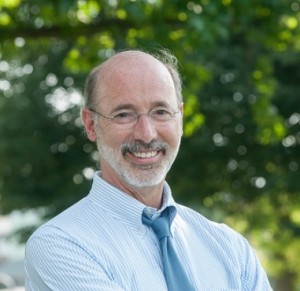Democratic candidates open wallets in Pennsylvania’s gubernatorial primary

By Andrew Staub | PA Independent
York County businessman Tom Wolf continues to lead three fellow Democratic challengers for the right to face Republican Gov. Tom Corbett his fall, but he had to open his wallet to get there.
Campaign finance reports show Wolf raised more than $14.5 million and spent $12.9 million on his gubernatorial bid, a large chunk of it on television commercials that sent him to the front of the pack.
When counting the spending from U.S. Rep. Allyson Schwartz, Pennsylvania Treasurer Rob McCord and former state environmental protection secretary Katie McGinty, the quartet of Democrats seeking their party’s nomination has collectively raised more than $35 million and spent more than $30 million on their campaigns so far.
LEADER OF THE PACK: Tom Wolf’s spending on television ads has helped spur his lead in the race for the Democratic nomination to face Gov. Tom Corbett his fall.
It’s the type of spending that can happen — and will continue to happen until the Nov. 4 general election — in a state that sets no limit on contributions.
Ellen Kaplan, policy director for the reform-mind Committee of Seventy, sees it as an unhealthy system that can dilute the power of individual voters who might question whether elected officials will care more about big donors than everyday constituents.
“It’s a pretty insidious perception that, really, I think contributes to people’s lack of confidence and trust in public officials,” Kaplan said.
While campaign finance reports are littered with examples of big-time donations, such as the $1 million former Bon Ton CEO Tim Grumbacher gave to Wolf and the $500,000 former Sallie Mae CEO Al Lord sent to McCord, Wolf’s personal spending has attracted much of the attention on election spending in the race.
Wolf helped finance his television rollout with $10 million of his own money — about $4.5 million of that borrowed from the bank — despite saying in 2008 candidates who self-finance “shouldn’t be a candidate.” He also accepted Grumbacher’s donation, even though he supports a $5,000 contribution limit and other campaign finance reforms.
“As Tom has said many times, candidates cannot rely on self-financing alone, they need broad support. Tom has raised over $4 million from thousands of donors,” said Jeffrey Sheridan, his campaign press secretary. “When Tom is governor, he will push for campaign finance reform, but for now he — like all candidates — are playing by imperfect rules.”
While McCord has said the election isn’t an “auction” and Schwartz questioned the personal loan, it hasn’t stopped Wolf’s meteoric rise to the front of the pack.
“They haven’t been able to show the voters any way that there was anything untoward about the loan and about the contribution to his own campaign. And it’s not mattered a whip to voters,” said G. Terry Madonna, a political science professor and pollster at Franklin & Marshall College.
Wolf is hardly the first wealthy person in politics, Madonna said. And self-funding doesn’t always guarantee a win, Kaplan said, pointing to millionaire Tom Knox’s loss to Michael Nutter in the 2007 Democratic primary for mayor of Philadelphia.
Still, the Committee of Seventy would like to see contribution limits and even a public financing system, Kaplan said. Other government watchdog groups agree Pennsylvania needs reform.
A report from The Center for Public Integrity gave Pennsylvania an “F” when it came to the Keystone State’s political financing system. The state scored just a 37 percent on the question of whether state regulations effectively govern political financing.
Campaign finance reform, though, has been a nonstarter, especially as the U.S. Supreme Court continues its trend of siding with unlimited election spending.
Those who don’t favor campaign-finance reform can argue unlimited contributions at least give them a shot against wealthy self-funded candidates, Kaplan said. But those that may not have massive bank accounts or enough name recognition to attract big-time donations could be left out, she said.
This year’s election, in particular, has shown the importance of having enough money to get on TV and get on it often. According to most recent poll from Franklin & Marshall College, 83 percent of registered Democrats have seen a television commercial for governor. Of those, 93 percent have seen a Wolf ad.
“That’s pretty stunning,” Madonna said, adding that observers see Wolf’s media blitz as the most persuasive introduction of a previously unknown candidate in modern state history.
The race hasn’t been the same since Wolf hit the silver screen, Madonna said, and he’s retained a perhaps insurmountable lead in polls heading into the election.
Kaplan, though, sees the effect of television advertising as a “sad political commentary,” considering 30-second sound bites don’t provide the best information to voters. Still, it might be the best bang for the buck, and there are plenty of those floating around the race.
It’s not just Democratic candidates raking in the big money, either. The Republican Governors Association sent $1.61 million to Corbett’s campaign war chest earlier this year.
The governor is also backed by Democratic power-broker David Cohen, the vice president of Comcast. He hosted a fundraiser that pulled in $200,000 for Corbett earlier this year, according to the Philadelphia Inquirer, which also reported that more than $45 million has been injected into the gubernatorial race.
To put that into perspective, more money has been spent on the campaign than is allotted to the Auditor General ($44.8 million) and the state’s drug and alcohol programs ($41.7 million) in this year’s state budget. It’s also enough to pay Pennsylvania’s annual $13.2 million contribution to Lincoln University for the next three years, while having some money left over, assuming the payment remains the same.
“And it’s not over yet,” Kaplan said.
Andrew Staub is a reporter for PA Independent and can be reached at Andrew@PAIndependent.com. Follow @PAIndependent on Twitter for more.







